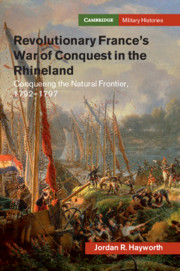Book contents
- Revolutionary France’s War of Conquest in the Rhineland
- Cambridge Military Histories
- Revolutionary France’s War of Conquest in the Rhineland
- Copyright page
- Dedication
- Contents
- Map
- Preface
- Acknowledgments
- 1 The Ancien Régime
- 2 The Brissotin Crusade for War
- 3 War, Conquest, and Disaster
- 4 The Organization of Victory
- 5 The Thermidorean Republic
- 6 The Directory’s War
- 7 A Shattered Army
- 8 The Generals’ War
- Conclusion
- Bibliography
- Index
- References
Bibliography
Published online by Cambridge University Press: 11 February 2019
- Revolutionary France’s War of Conquest in the Rhineland
- Cambridge Military Histories
- Revolutionary France’s War of Conquest in the Rhineland
- Copyright page
- Dedication
- Contents
- Map
- Preface
- Acknowledgments
- 1 The Ancien Régime
- 2 The Brissotin Crusade for War
- 3 War, Conquest, and Disaster
- 4 The Organization of Victory
- 5 The Thermidorean Republic
- 6 The Directory’s War
- 7 A Shattered Army
- 8 The Generals’ War
- Conclusion
- Bibliography
- Index
- References
- Type
- Chapter
- Information
- Revolutionary France's War of Conquest in the RhinelandConquering the Natural Frontier, 1792-1797, pp. 311 - 331Publisher: Cambridge University PressPrint publication year: 2019



